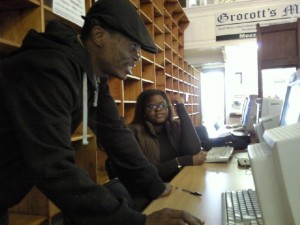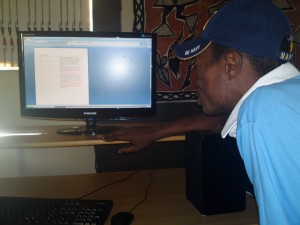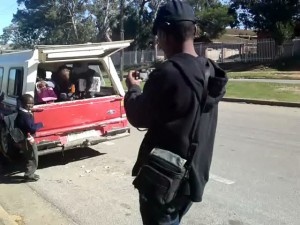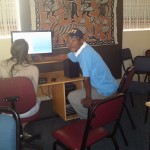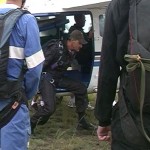A short personal documentary by Rogan Kerr; exploring the ups and downs in the life of a student and how it always helps to have a friend there to pick you up… And they don’t come much quirkier than Kingtits.
Two Passports, No Country
A personal documentary about a family and it’s national identity (or lack thereof) in South Africa.
Working with Thembeni: Citizen journalism
Despite our anxieties, however, luck was on our side. Thembeni was praised by the Chief editor of Grocotts, Kwanele Bhutane as being one of the best citizen journalists Grocotts had, having published several stories on the Grocotts mail website over the last few months. This would be an advantage when it came to finding stories to film because it meant he already had a sense of what was newsworthy and what was not. When we finally did meet, we shared brief hellos and got right down to work. Tamsin and I explained to Thembeni the fundamental aspects of filming stories such as the difference between finding stories for print and finding stories for television. We explained the meaning of terms such as ‘visually compelling’, ‘six second shot rule’ and lighting. His countenance at this point had shifted from jovial to worried (a look we would come to see plenty of over the next few weeks!) and Tamsin and I attempt to calm him repeating that it was not as hard as it sounded to film stories once you ‘got the hang of it’.
For that first week we assigned Thembeni to film a ten second clip of news stories he was already working on for Grocotts as a print stories. The first story was that of the illegal transportation of school children in vans which was deemed unsafe by the South African Government. The second story was covering the march that had been organised by Mary Waters high school students outside the Magistrates court, to protest the bail applications of two men, who allegedly raped a female student from their high school. The clips Thembeni filmed were very good for first attempts at filming and even included a skill we had not taught him, panning! After congratulating him on his work, we wasted no time in planning for the next assignment, a one minute piece which would undoubtedly require more effort on both mine and Tamsin’s side, as well as that of Thembeni.
We agreed that a continuation of the Mary Waters story he would be telling with one of the ten second clips would be ideal and were exhilarated to learn that Thembeni had heard rumours of community members wishing to demolish the abandoned house where the rape occurred. By removing the scene where the horrific incident occurred, the community wanted to show their intolerance for such crimes and prevent a repeat of the same crime befalling another student (since the area around the house was surrounded by schools). In high pitched voices laden with excitement Tamsin and I explained the potential behind capturing bulldozers ripping down walls with community members tearing up, watching on the sidelines. Filming stories had certainly made an impression on what counted as excitement in our lives! Unfortunately when the day came for us to accompany Thembeni to shoot the story, we were disappointed to find that the demolition team consisted of two men who were taking apart the roof and probably would not get around to tearing down the walls until at least 2 weeks later. We did however make the most of it and shot as much footage of pounding hammers as possible instructing Thembeni afterwards on how to shoot sequences. Once again, those familiar worry lines appeared on his face and once again Tamsin told him not to worry!
When Thembeni was free one afternoon we invited him up to the journalism department where we showed him what we meant by sequences by making him watch our how to videos. At that point he understood what we had trying to explain to him and managed to film at least 3 sequential shots for the final story. Up until this point we had suffered no horrendous hiccups, but a large one loomed over us like a dark cloud and would release its might as soon as we would start editing!
Formats formats formats! The one downside of working with cellphone footage is having to change various formats into other formats before using editing software designed for ‘proper cameras’. Despite the problems it gave us, Tamsin and I stuck with Windows Movie maker as we felt it would benefit Thembeni to learn how to edit on it, since he could access it through the Grocotts computers. After converting his footage from QuickTime., to wmv. we started the editing process and quickly learned that Windows Movie Maker was not necessarily as difficult to use as Adobe Premier Pro, (the software we were taught how to use in first term) it was just twice as slow and gave us twice as many problems, freezing constantly. Eventually we did finish editing it, with narration. Thembeni, having worked as a newsreader at Rhodes Music Radio required little guidance apart from pace instruction, when recording his narration.
When reflecting on the whole experience of working with a citizen journalist Tamsin and I agreed that while it was much easier to work with a television crew that knew just as much as you did, it was good feeling to know that you helped teach someone something they otherwise might have never known. The live television show was a pleasant way of marking the end of our working relationships with Thembeni, after all that hard work he was able see what it was all for.
View Thembeni Plaatjie’s story map in a larger map 
Zukiswa Gubevu, fully-fledged citizen journalist
By Andiswa Leve and Kyle Robinson
Initially the idea of teaching someone else to learn the intricacies of journalism seemed quite daunting. Did we, as third year students, really know enough about the profession to literally guide them step by step to becoming well equipped, in order to best reflect and provide coverage events in their respective communities? We soon found out it was going to be a long but rewarding experience.
Our first meeting with our citizen journalist, Zukiswa Gubevu was at Grocotts Mail on a Sunday afternoon. We had decided that this was an apt location because she was familiar with the area and we wanted a neutral setting for our first encounter.
She came prepared with camera in hand, because her cell phone camera had been stolen. We were quite impressed with her having organised an alternative to not having a camera. Initially she was shy and soft spoken, but as we spent more time with her, providing her with a breakdown of what was required of her from us, and vice versa, she became more comfortable. She seemed very interested, asking questions when she was unsure of what was going on.
On that first day we taught the basic principles and technicalities of using a camera. We provided explanations of ‘rule of thirds’ technique, sequences, and how to position the camera when she was filming things that were either near or far. She became familiar with the ‘TV jargon’, and most importantly we could see that she applied what we had taught her well.
Soon came the time for our CJ to put the theory we had taught her to practise. It was time for her to begin finding news worthy stories, ‘keeping her ears to the ground’, and really become a investigative journalist.The first assignment required the CJ’s to produce a short clip. On numerous occasions she did not respond to either of our attempts to get hold of her. We were frustrated and worried but eventually, we made contact with her again. Zukiswa did her first clip on the fencing project that the Makana Municipality is currently busy with. 
We were very impressed with her technique and the fact that she genuinely had a good eye, capturing footage of a really high quality. Her only downfall was that she had not gathered enough information and contact details to substantiate what she had captured. We then went back to where the fencing was being constructed and she was again in her element. We could not believe that this was the same person who was so shy and timid the first time. Now she had her camera, notebook and pen in hand as if she had been a journalist all this time. She asked the right questions, the ‘who, what, where why and when’ and ‘how’. We were really impressed with her story and the obvious commitment she had to her story and this project as a whole, despite the previous mishap.
Another challenge, other than that of miscommunication, was the fact that Zukiswa did not always articulate herself well in English, but Andy spoke to her in Xhosa to make sure that we all understood what we expected of each other.
The latter came to the fore when she had to go and get comment from The Department of Education for her video story. Of course she was in unfamiliar territory and it was to be expected. We guided her along, and by the end of the interview she was more confident, asking questions and writing the answers down. We had witnessed her blossom and take such a professional stance within a matter of minutes- again another proud moment, and we had soon forgotten about all the troubles from before.
Her video story took her to Joza in the Grahamstwon township, as can be seen in this map.
View Larger Map
It looked at how children in the township have to walk long distances to school in the early hours of the morning, even though they had applied to be fetched and dropped off in their respective extensions. Her story was exactly that- a story, not just a clip or a 30 second video. We were very impressed with the story and the fact that she had chosen to take this on, as opposed to taking a small clip and not really having a STORY.
story was exactly that- a story, not just a clip or a 30 second video. We were very impressed with the story and the fact that she had chosen to take this on, as opposed to taking a small clip and not really having a STORY.
Her work ethic was much appreciated. Our patience was tested at times but her quick learning and the final piece that she produced was amazing. Within a mere 5 week period she is a fully fledged citizen journalist. I think for us, it all came to be a rewarding experience at the end. There were times when we honestly didn’t know what to do when she did not respond to us, so much so that we had to go to her house! However, in retrospect, it was a rewarding experience and one that we hope Zukiswa gained all that she had hoped to for it to be.
The thrill of skydiving
By Kyle Robinson and Bradley Janssen
Skydiving is a sport that appeals to many because of the thrill of the adrenalin rush. However, others are more worried about their personal safety, and would not trust themselves to jump out of an aeroplane. This piece investigates the dangers of skydiving, and follows the entire training process of two men about to jump. We see them learning the theory, and then learning the practical side. It reveals how seriously EP Skydiver’s, based outside Grahamstown, take their safety precautions.
Child’s Play-Amnesty International
Amnesty International is a worldwide movement which campaigns internationally for human rights for all citizens. This public service announcement aims to fight and make people aware of the discrimination that is taking place in various societies. This PSA cleverly uses the symbolism of jelly babies to represent race and colour, while at the same time playing on the children’s preferences for which colour jelly babies they like as a form of inclusion (acceptance) and exclusion (discrimination). We must fight discrimination- it is not fair!!!
